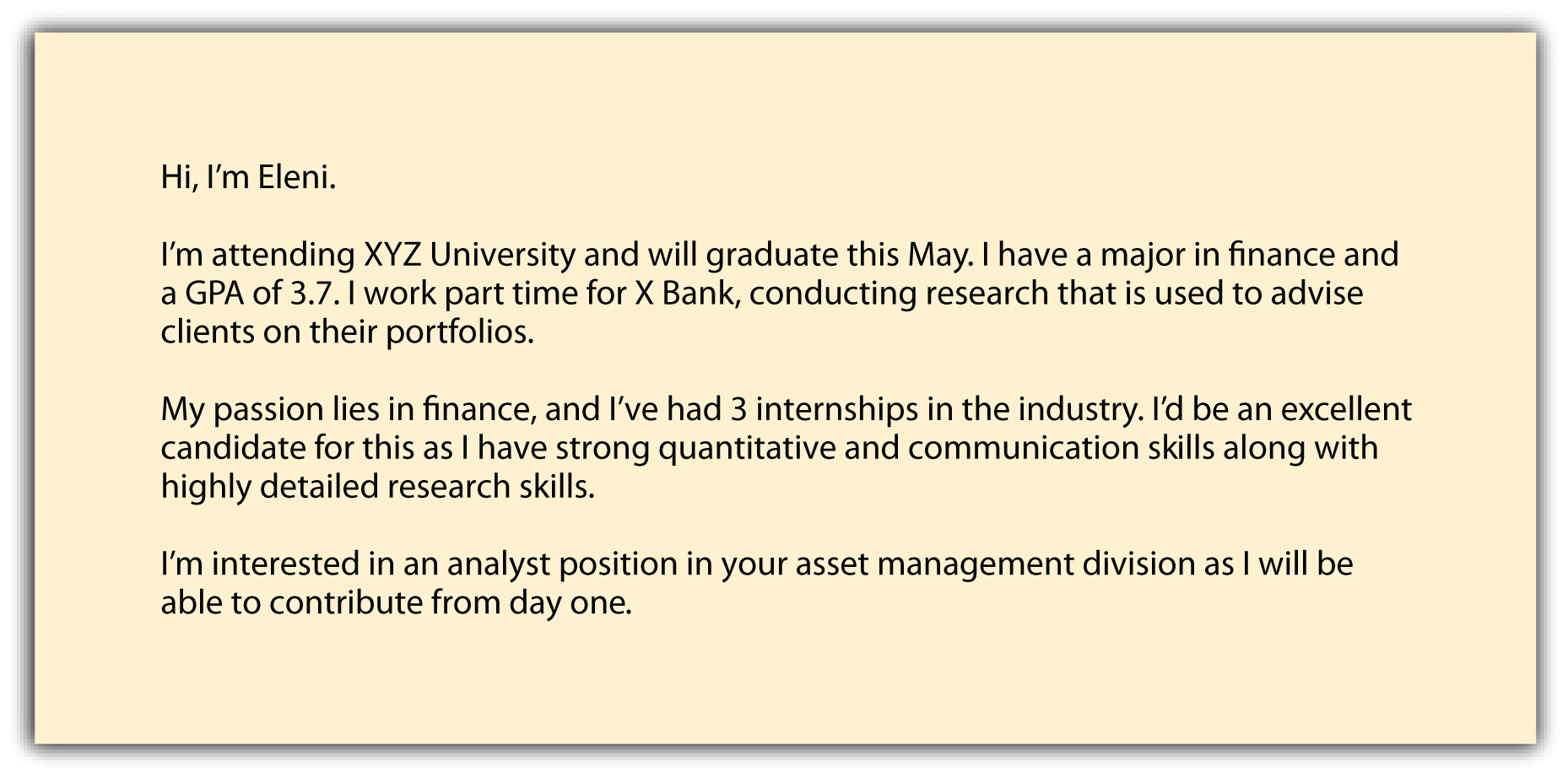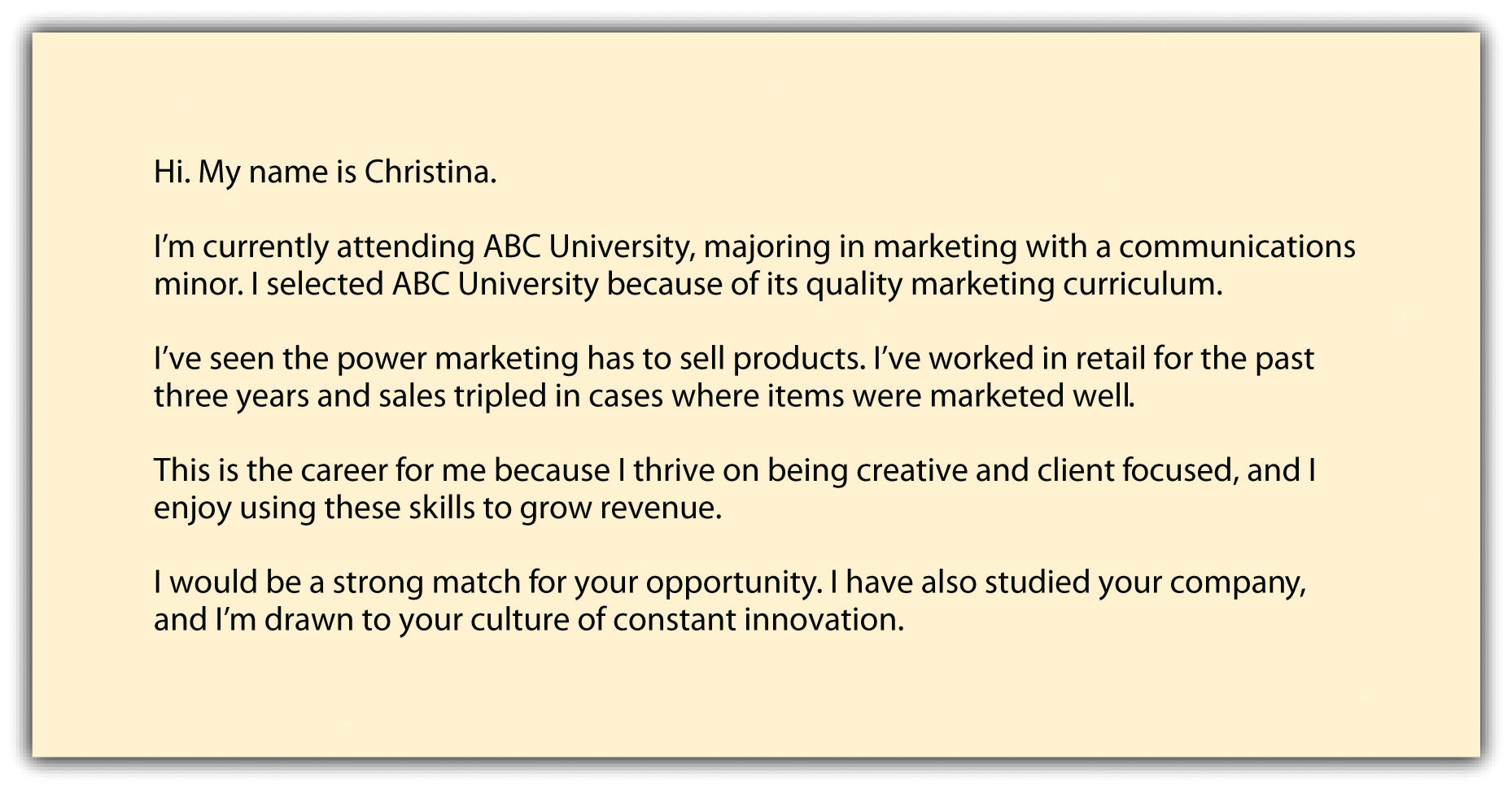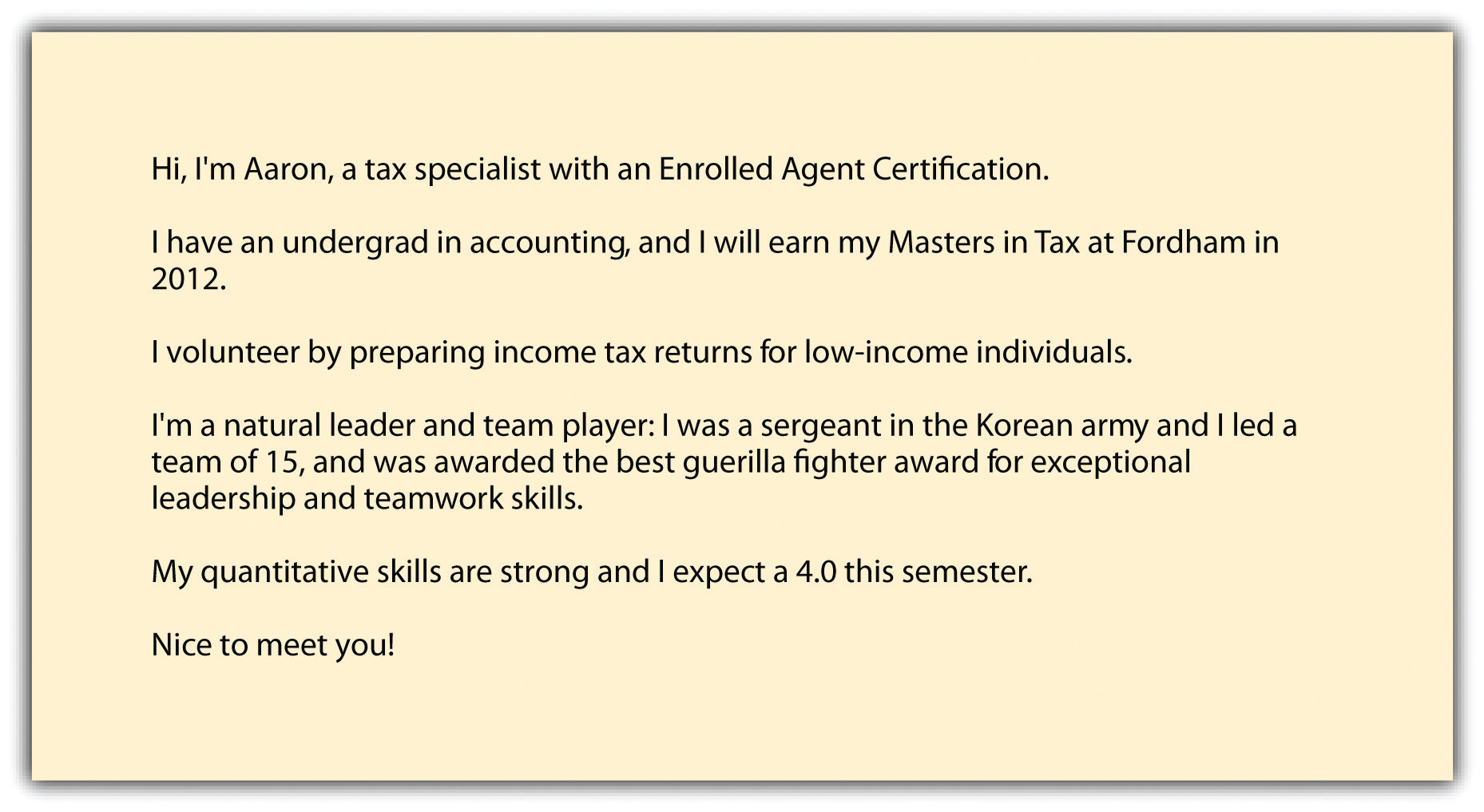1.4 Your Networking Pitch
Caroline Ceniza-Levine and Connie Thanasoulis-Cerrachio
A networking pitch was originally termed an elevator pitch because, in the time an elevator takes to go between floors (generally thirty to forty seconds), you should be able to articulate your value proposition (the skills you have and the position you are seeking). The elevator pitch is now also called the professional pitch or networking pitch.
This thirty- to forty-second summary should be spoken, or delivered, in a confident and convincing manner, making a strong impression. If your pitch is too long and drawn out, it lacks conviction. When meeting networking contacts, recruiters, and hiring managers, this is your chance to make a great impression and present yourself with clarity. No one wants to listen to a long, drawn-out speech. Make your pitch clear and concise, enabling the person who is listening to know exactly what type of job candidate you are. Networking pitches can be used in other networking setting including at conferences, tradeshows, industry gatherings, and on LinkedIn.
How do you craft an effective pitch? Three steps will ensure your success:
- Write your pitch for a specific interview or networking situation.
- Edit your pitch so that you are using clear, concise, and concrete language that is customized to the situation.
- Practice delivering your pitch verbally, and further edit it as needed because we do not write the same way that we speak. Continue rehearsing and repeating your pitch to ensure that your delivery is natural, convincing, and authentic.
Any information you can share that distinguishes you from others is very helpful. Perhaps you have something unique in your background:
- You speak two or three languages.
- You lived abroad for a particular length of time.
- You achieved something significant athletically or creatively.
- You volunteered in a meaningful way and perhaps raised extraordinary funds for various charities.
Distinguish yourself from others in whatever way you can to ensure you are remembered in a positive light.
You will deliver your pitch at different times and occasions, including the following:
- Career fairs present an opportunity to meet representatives from various companies. These individuals will meet many students or candidates, so it is important that you make sure your pitch is short and crisp. Also be certain to do your research on their company, as many candidates do not.
- Networking events enable you to first meet someone in a more relaxed setting.
- Interviews often begin with the interviewer asking for a summary of your background or asking that you take one or two minutes to let them know about you. Include high-level themes in your past (e.g., you have always been involved in healthcare at some point in your schooling and in your career). If themes are not apparent, talk about your achievements and the quality of your efforts.
Step 1: Write Your Pitch
Your pitch should answer the following five questions:
- What is your educational background? Detail the college or university you attended, your major and minor, and your expected degree and graduation month and year.
- Do you have any pertinent experience in the field in which you are interested?
- What are your critical skills, strengths, or passions? Highlight your top two or three skills and if you have a passion that is driving you toward a certain kind of work or position.
- What do you want to do? Be specific regarding industry, function, and geography.
- Why would you be good at the position? Focus on presenting your top two or three skills, and the skills you have that are necessary to succeed at the job you are targeting.
Type the answers to the preceding five questions, trying to fill one complete page (8½ × 11).
Step 2: Edit Your Pitch
Once your pitch is written, review and edit it accordingly. You should use words that come naturally to you because the more natural the delivery, the more impressive the pitch. Revise general or vague language (ex. “I have always enjoyed helping others,” “I have learned many things,” “I want a job where I can grow”) and replace it with specific and concrete language (ex. “Since my freshman year of high school, I have worked in customer service roles,” “in my management courses, I have learned about how to collaboratively solve personality-driven conflict,” “I want a summer internship where I can assist the office of talent development in program appraisal”). Here are some additional steps you can consider while editing your pitch:
- After you edit the one-page answers to the pitch questions, ensuring that you have covered all the important items, cut it to half a page; this forces you to prioritize the essential elements.
- After you edit the half-page document, ensuring that you have covered all the important items, cut it in half again (it is now one-quarter of the page); this forces you to be even more ruthless in prioritizing.
- After you edit the quarter-page document, ensuring you have covered all the important items, cut it in half again, leaving only four or five key bullets; this forces you to be concise and select just the most important items.
Step 3: Practice Delivering Your Pitch
Once you have the final pitch in writing, you will need to practice, then practice, then practice some more. Your pitch should be spoken in a confident and compelling manner without notes.
- Deliver your pitch out loud to ensure it flows smoothly and addresses your career highlights. Practice it until you have the main points memorized. Practice until you can repeat it when someone shakes you from your sleep at 3:30AM and you maintain your passion when saying it.
Sample Pitch 1

Sample Pitch 2

Sample Pitch 3

Sample Pitch 4

AI Insight: Reflective Conversations
When creating your elevator speech, it’s important to understand that AI writing tools can assist in refining your ideas, but they cannot truly capture what makes you unique. These systems are trained on vast amounts of general data, and when asked to generate content like an elevator pitch, they often produce responses that resemble a standard job applicant’s profile—one that’s generic and doesn’t showcase your distinct passions, experiences, and aspirations. To avoid this, your pitch must reflect your individuality, something AI can’t fully comprehend. Instead of asking AI to write your elevator speech, think of it as a tool to help you refine and polish your message once you’ve had the opportunity to reflect on what really matters to you.
To begin crafting a pitch that is personal and authentic, try engaging in a reflective process to identify what makes you unique, interesting, and passionate. This process is less about what you think an employer wants to hear and more about uncovering your authentic voice. To help you think through these ideas, engage in a conversation with yourself. Here are some sample prompts you can experiment with in an AI large language model (like ChatGPT) to refine your thoughts:
Sample AI Prompts for Self-Reflection:
- “Can you help me explore what makes my experience unique by asking questions about my interests, past experiences, and skills?”
- “What are some ways I can explain my passion for [subject or field] in an elevator pitch?”
- “How can I describe my strengths in a way that goes beyond clichés like ‘hardworking’ or ‘team player’?”
- “Can you ask me questions to help me clarify what drives me professionally?”
- “Based on my skills in [list specific skills], how might I communicate these in an impactful way?”
Key Takeaways
- A networking pitch articulates your value proposition (i.e., the skills you have that match the position you are seeking).
- Your pitch should contain your educational background, experience related to the field in which you are interested, your critical skills and expertise, what you want to do, and why you would be good at it.
- Writing your pitch and editing it will enable you to get the right content and tone.
- Practicing the delivery of your pitch will ensure your delivery is natural and confident.

